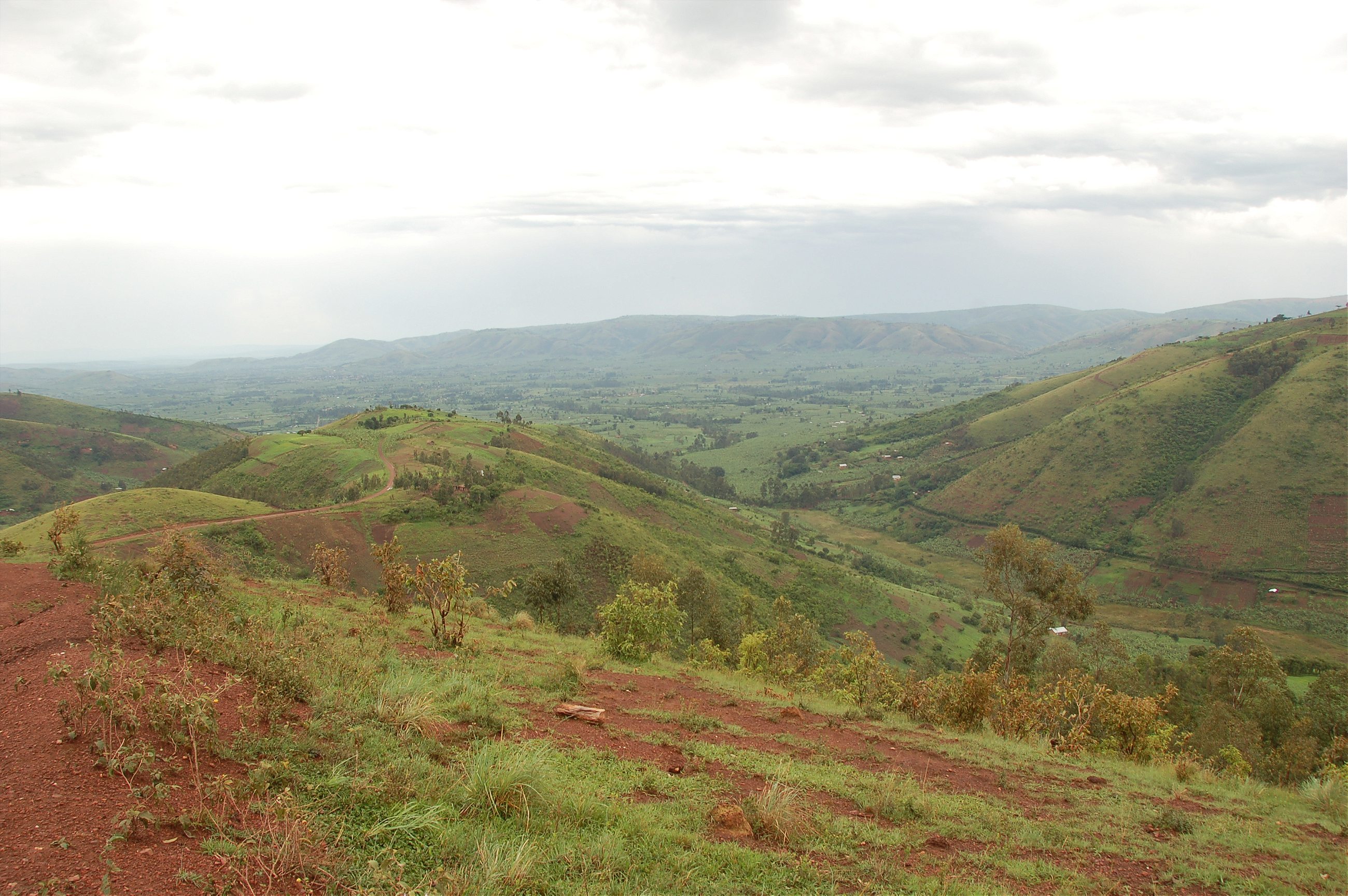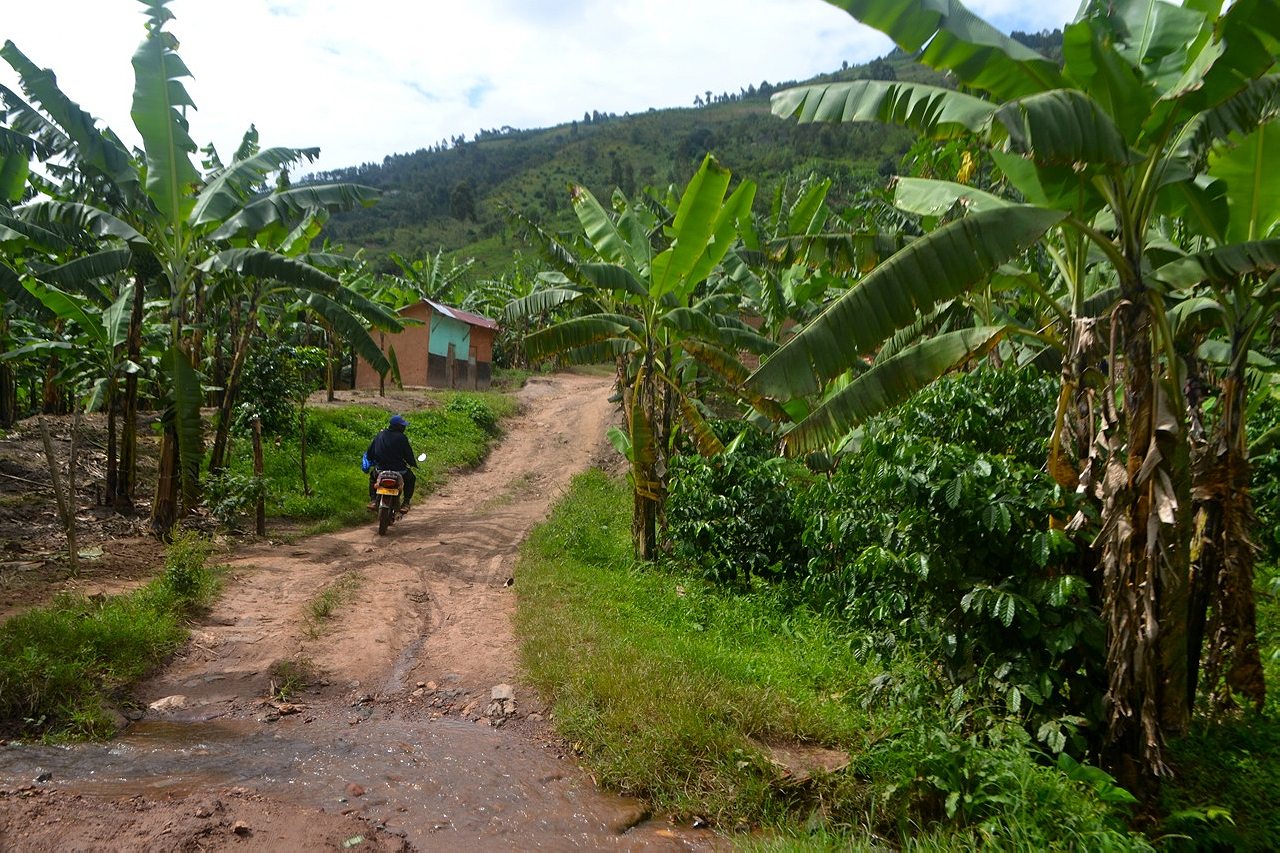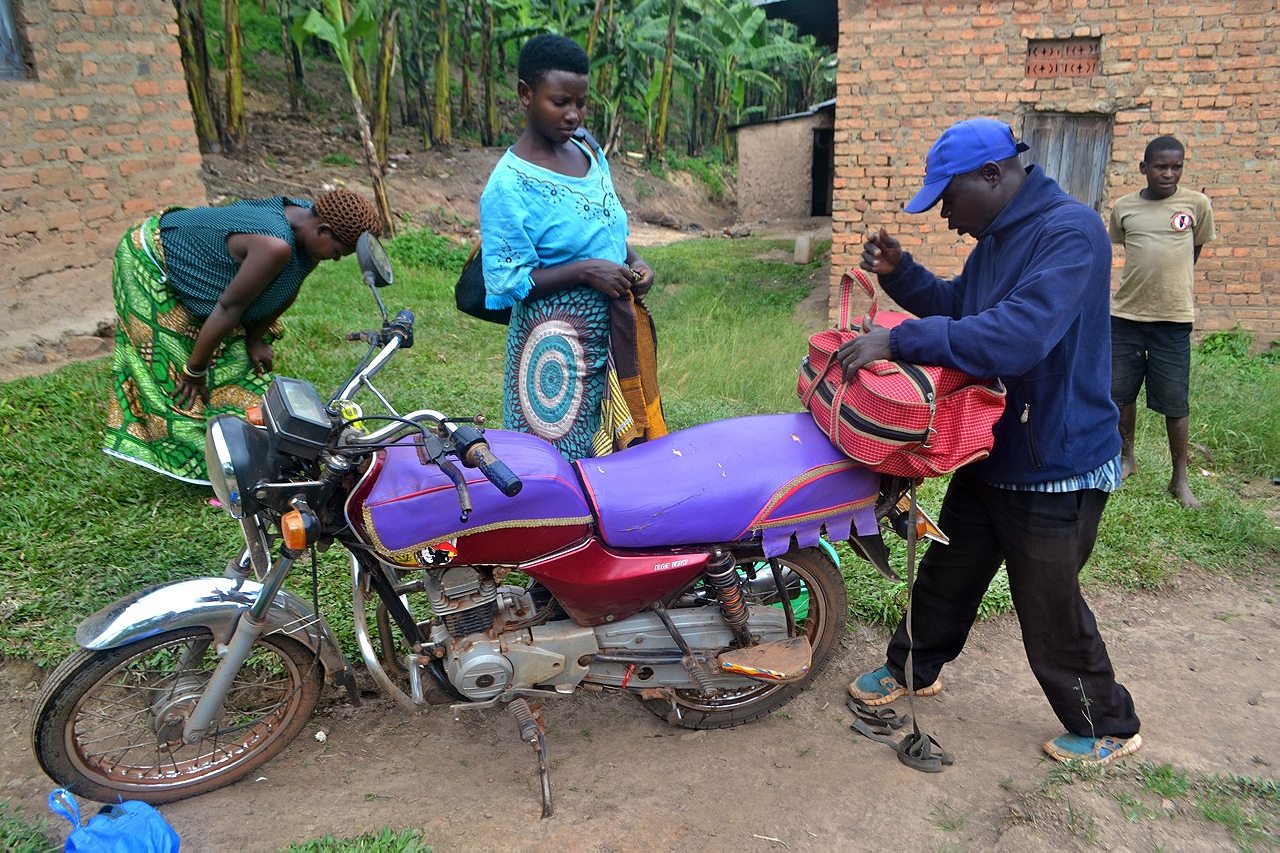To help save pregnant women in remote Ugandan villages, public health programs are turning to motorcycle taxis, a notoriously dangerous mode of transport.
RUHIIRA, Uganda—
“We go!” Joshua Tusubira waves at me impatiently, swinging his leg over his motorcycle and revving up the engine. “A mama called from the deep, deep village!”
Within moments of receiving the phone call, Tusubira has connected his motorcycle to the mobile stretcher stationed at the health center, whipping his fingers at the final metal nut to spin it into place. The mobile stretcher is a bright red contraption on two wheels: a larger, more serious version of the child bike trailers that fitness-conscious parents tow in suburban America.
I hop on a second motorcycle, and soon we’re hurtling down dirt roads, swerving to avoid the ditches carved out by the torrential downpours of the rainy season and sending clouds of dust billowing behind us. Villagers turn their heads at Tusubira and the strange apparatus he’s pulling. The parish residents break into incredulous smiles or stare gape-jawed; schoolchildren scream and chase after Joshua for as long as they can.
Tusubira is a boda boda man—a motorcycle taxi driver—in rural Isingiro District, southwestern Uganda. He’s not just any motorcycle taxi driver, though: He is the head motorcycle ambulance driver of the United Nations Millennium Villages Project’s new emergency referral system for pregnant women and children under five in Ruhiira Parish.

Review of maternal and child deaths in the area revealed that a disproportionate number are due to lack of timely transport to the health center. Although the Millennium Villages Project has one ambulance car, it is unable to respond to all emergency calls, primarily because it’s often already en route to Mbarara Regional Referral Hospital, 1.5 hours away from Ruhiira Parish.
Boda bodas originated on the Kenyan-Ugandan border in the 1960s and 70s as bicycle taxis that transported people across the no-mans land between the Kenyan and Ugandan border posts. They provided an option for people who wanted to avoid the paperwork for using motor vehicles to cross the international border. Boda boda is corrupted English for “border-to-border”—what the bicycle owners would call to potential customers.

Over time, motorcycle taxis have increasingly replaced the bicycle taxis, and boda bodas have become the leading cause of death and injury on most Ugandan roads. The number of boda boda accidents has risen eight-fold in the past eight years. Due to boda boda accidents, an average of two patients die every week, between 10 and 20 victims are received every day, and 20 percent of victims are left disabled—at Mulago National Referral Hospital alone. Peace Corps Volunteers, U.S. Mission employees, and their dependents are prohibited from using boda bodas.
But now public health programs such as Millennium Villages Project and UNICEF are commissioning boda bodas as emergency transport from remote villages to health centers. Complete with an attachable stretcher on wheels, the boda bodas work to reduce maternal and child death due to lack of transport. Almost all emergency cases in Ruhiira are women in labor.

Tusubira denies that boda ambulances are unsafe. “We are trained how to ride. We have a specific speed we are supposed to ride on if we are carrying patients, so there cannot be any accidents.” He taps the giant white number printed on the bright red ambulances: 25 kilometers per hour. The speed of the boda ambulance also depends on the condition of the road and the patient. Tusubira stops his motorcycle during his pregnant passenger’s contractions and only continues when the contractions pass. “You don’t know how tough the contractions are, maybe she will be moving, moving around, and she will end up doing what? Falling down.” He shoots me a skeptical side-glance when I suggest that he could continue rushing the woman to the health center during contractions.
According to UNICEF, a woman in sub-Saharan Africa, a region that includes Uganda, has a one in 16 chance of dying during pregnancy or childbirth, vastly outpacing the one in 4,000 risk in a developed country. This is the largest difference between poor and rich countries of any health indicator. Poorer women living in rural areas with little access to health services are the most likely to die in childbirth. They are unwilling or unable to pay for transport to a health center. Research says the single most important intervention to reduce maternal mortality is to ensure that transport is available to a health center where a trained health provider with midwifery skills and quality emergency obstetric care are available.
This is why Tusubira is now honking and maneuvering around cows with a big red ambulance stretcher in tow; an expectant mother just called, her contractions coming more frequently. She needs to get to the health center as soon as possible.

Tusubira and his team of boda ambulance drivers usually don’t use the mobile ambulance stretcher. Between the beginning of Ruhiira Parish’s boda ambulance program in November 2014 and April 2015, Tusubira and his team have transported 68 emergency cases. Only one of them used the ambulance stretcher. Pulling the 143-lbs. ambulance stretcher consumes more fuel, the boda ambulance drivers complain. It also takes more time to go to the health center where the stretchers are safely stationed, hook up the stretcher to the motorcycle, and then pick up the emergency case, compared to driving directly to the emergency case’s location.
Once, when one of Ruhiira’s boda ambulance drivers came for a pregnant woman after first picking up the stretcher, he found that she had become impatient and already left with a regular motorcycle taxi driver. Many rural Ugandan mothers in labor have little problem with sitting on the back of a motorcycle if they can get to the health center faster. Millennium Villages Project is concerned though, pushing for more use of the stretcher.
I watch as Tusubira climbs a particularly steep hill and bumps over to the downward slope. The mobile ambulance tips momentarily on one wheel, but then it rights itself. We stop at the beginning of a narrow rocky path, where Tusubira detaches the ambulance stretcher.
As soon as we continue down this path, it becomes apparent that it would have been impossible to traverse this with the ambulance stretcher. This route is nothing more than the jagged, bare rockface of the hill. The motorcycle bumping over toothy pieces of rock jolts me several inches off my seat and into the air multiple times. After sloshing through a creek running through matooke plantain plantations, we arrive at the woman’s house.
Tusubira strides inside and emerges carrying the woman’s basin and tote bag. Doreen, the very pregnant woman, follows him out of the house and waits as Tusubira unfastens a long black rubber strap from the back of his motorcycle and ties on the tote bag. One of Doreen’s female relatives, who will feed and care for Doreen as her attendant at the health center, climbs onto another boda, and we set off on the precipitous climb. All the boda drivers have to put their feet on the ground from time to time, pushing off the rock and the dirt banks of the narrow path to get their motorcycle and passenger up the incline.

When we reach the top, everybody disembarks while Tusubira reconnects the ambulance stretcher and his motorcycle. Doreen is bent over, palms on knees and large brown eyes shining with distress. She is quiet except when she laughs once at something her attendant says; having never seen anything like the mobile ambulance, Doreen is afraid of riding in it.
Meanwhile, Tusubira works silently and efficiently, fingers flying over his motorcycle. He lifts the hood of the mobile ambulance, and Doreen climbs onto the reclined mattress inside. Then we are off again. Doreen’s attendant, who is now seated behind Tusubira on his motorcycle, casts several backwards glances at the ambulance weaving back and forth behind them, but the ride goes smoothly.
Upon arrival at the health center—80 minutes after the call— Tusubira hands over the mother to the midwife on duty. This time, the midwife is here. When Tusubira finds the midwife absent—unsurprising for Uganda’s small and overworked health worker population—he goes off to fetch her to attend to the mother in labor. Tusubira typically waits 20 minutes until the midwife updates him on the patient’s condition and in case he is needed.
Because there is often only one midwife on duty, Tusubira finds himself giving her a hand, passing the midwife gloves, cotton, the resuscitator, and other tools. While waiting, he fills out the ambulance program’s logbook, detailing information like the patient’s name, pickup time and location, and time of arrival at the health center. He hears Doreen is doing well—she is seven centimeters dilated upon arrival—and he is free to go. Tusubira will be reimbursed approximately $4 per emergency case at the end of the month.

Tusubira learns of emergencies when the pregnant woman or Community Health Worker responsible for her calls Tusubira’s private cell phone number, which was distributed over a local radio program, and directs him to the pickup location.
Locating the emergency case for pickup is no easy feat. Street signs and addresses are rare in Ugandan towns; in the villages, they are non-existent. Landmarks are scarce to the untrained eye: colorful patchwork quilts of hills dotted with trees are ubiquitous, and the occasional roadside shops made of cow dung and ash look identical. For Tusubira, that’s no problem: “That is why they picked us. We know this area, we know the roads, each corner, each of the households.”
I ask Tusubira about the craziest experience he has had as a boda ambulance driver. He has the demeanor of a jokester when he is not working, his eyes twinkling with a lively, mischievous glint. But when you ask Tusubira questions, he gets serious and contemplative, pursing his lips as he listens and looking off into the distance through his thick eyelashes as he thinks. “There are these beds!” Tusubira picks up and waves around the rubber-cased foam mattress inside the ambulance stretcher. “They really help the mother.” He pauses and then adds, “Maybe one surprise that I ever got was when I was bringing the mother, the mother delivered.”
While the pregnant woman was sitting behind Tusubira on the back of his motorcycle, she suddenly grabbed him, due to her contractions. Tusubira stopped, and the woman climbed off the boda, yelling, “Nooo, I am going to deliver! I am going to deliver!” He carried the woman to the nearest house. As they arrived, the baby’s head was crowning, and by the time he returned to the house with the first aid kit from his motorcycle, he found the mother-in-law, who had accompanied the pregnant woman, cleaning the delivered baby. Tusubira went to pick some water to wash with; they cleaned the baby and mother, packed up, climbed back on the boda, and continued onto Ruhiira Health Center.
Maybe I saved her
When Tusubira reflects on the experience, his main emotions are relief and pride that there wasn’t an accident when the woman abruptly grabbed him. He also acknowledges the reason that the boda ambulance drivers elected him as their head. He is “too much in knowing how a family goes,” being married the longest and having six children himself. “In the way that I am a parent, I felt happy when I saw the mother getting her baby. They [the mother and mother-in-law] were so happy, and they told me, ‘God bless you!’”
Tusubira is not above being forceful to get his job done. One woman in labor refused to go with Joshua after he responded to a Community Health Worker’s call. She preferred to walk to the health center. Finally, Tusubira threatened her, “What if you get any problems? If you refuse to climb the motorcycle, we are going to bring policemen here for you. Because this is a motorcycle that is supposed to take you to the hospital.”
She ultimately agreed to travel to the health center with Tusubira, and within 10 minutes of arriving, the woman delivered. “If I left that woman, by the time she moved, she could have delivered on the roadside, have a really bad problem, anything wrong happens,” he says. “At least, maybe I saved her.”